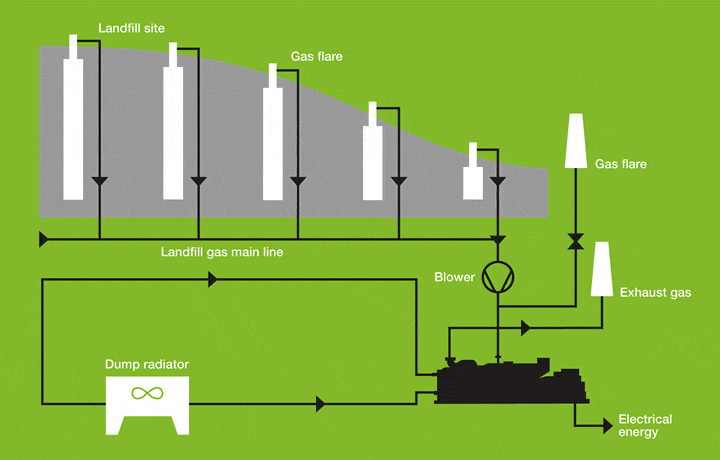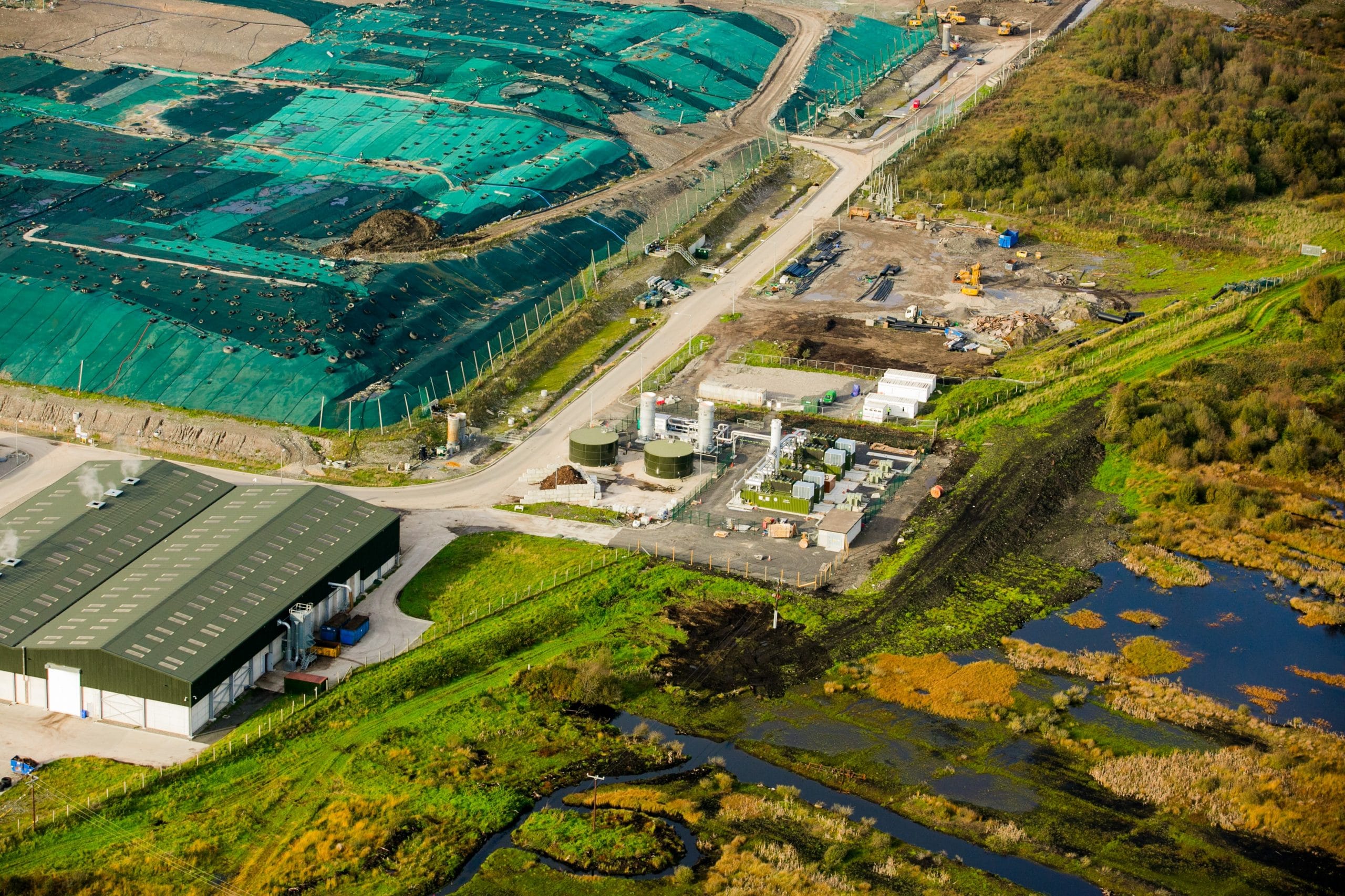Landfill gas is created during the anaerobic decomposition of organic substances in municipal solid waste (MSW) and commercial and industrial (C&I) wastes that has been deposited in a landfill site. Depending upon the landfill design and its management, as well as waste composition, compaction, moisture and several other factors, thousands of landfills are available worldwide to collect and utilize this valuable renewable energy source for power generation. If landfill gas can escape to atmosphere, methane contained within it is a powerful greenhouse gas, 21 times more so than carbon dioxide. Therefore, its prevention of escape to atmosphere and its utilization as a renewable fuel source is a win-win situation.
Landfill Gas Collection
For a landfill restoration that prevents greenhouse gas from migrating into the atmosphere while avoiding offensive smells and smoldering fires, the gas must be continuously extracted under controlled conditions. Perforated tubes are drilled into the landfill body and interconnected by a pipework system. Using a blower, the gas is sucked from the landfill. A well-designed gas collection system will flexibly capture the landfill gas from various spots and handful high temperatures, leachate, condensates and air content – thus ensuring a cost-efficient collection as well as stable landfill gas quality. Several engineering companies specialize in this field and offer their services on a worldwide basis.

Landfill Gas Composition
Landfill gas composition and production rates are primarily affected by the waste that has been deposited in the landfill site along with the local atmospheric conditions. MSW contains 150-250 kg of organic carbon per tonne which micro-organisms convert to landfill gas via anaerobic processes.
The gas formation is influenced by several factors such as waste composition, landfill storage height and density, air temperature, atmospheric pressure and precipitation levels. Landfill gas production starts soon after the waste is deposited in the landfill and may last 15-25 years. The continuously decreasing landfill gas volume can be compensated by the disposal of additional waste during this period. With a calorific value of 3.5 to 5.5 kWh Nm3 (35-55% methane), landfill gas constitutes a high-value fuel for gas engines that can be effectively used for power generation.
| Landfill gas component | Composition (by volume) |
| Methane (CH4) | 35-55% |
| Carbon dioxide (CO2) | 30-44% |
| Nitrogen (N2) | 5-25% |
| Oxygen (O2) | 0-6% |
| Water vapor | Saturated |
Consequently, 1 million tonnes of MSW generate 1.7-2.5 million m3 of collectable methane, enough to fuel a gas engine capacity of 850-1,250 kWe producing 6,500 to 10,000 MWh of electricity per year. That roughly corresponds to the average power demand of 1,500-2,200 EU households.
Jenbacher landfill gas engines
The broad range of Jenbacher landfill gas engines is specifically designed to run at full load with high efficiency and high availability, despite a low heating value and fluctuating gas quality and pressure. The high quality and specially designed engine parts resist the impurities that usually appear in this type of fuel. Before the landfill gas can be fed into the gas engines, it needs to be dried and compressed. Severe contaminants such as siloxanes should be removed by activated carbon or other technologies if exceeding a certain level. Not only will these measures considerably increase the availability of the generator, but they will also reduce the costs associated with operation.
Since landfills are usually located near big cities, emission standards are becoming more and more rigid in many countries. To comply with these standards, the whole system must be managed, beginning with the fuel gas conditions up to the installation of an exhaust treatment service, if needed. Clarke Energy is committed to not only supplying the gas engines, but also offering ancillary equipment and giving support for an integrated solution, from the gas flange to the grid connection.
Advantages
- Smooth operation despite low heating value and fluctuations in gas composition and pressure.
- Electrical efficiency of up to 45%, and up to 90% efficiency in the case of combined heat and power.
- Low weight containerized units that are easy to move and adjust to changing project capacity.
- Basic design and support for gas conditioning, if required.
- AIR: Integrated exhaust after-treatment solution complying with country-specific standards.
- Flexible contractual service agreements.
- Alternative disposal of a problem gas while simultaneously harnessing it as an energy source.
- Revenues for power and heat production when fed into the public grid.
- Carbon credits for reduction of methane releases or special renewable energy tariffs.
Our Competence
Clarke Energy has installed and commissioned approximately 1GW of landfill gas generation equipment globally and is one of the leading players in its field. The Clarke Energy and Jenbacher product teams offer an unparalleled breadth of expertise, references and solutions. These plants generate about 11 million MWh of electricity annually, enough to supply more than 2.7million European homes. In addition, by capturing landfill gas instead of emitting it directly into atmosphere and using if for power generation in place of fossil fuels, these engines can reduce greenhouse gas emissions by about 40 million tonnes CO2 equivalent each year. The amount of greenhouse gas emission savings equals the annual emissions related to nearly 22 million EU passenger cars.


